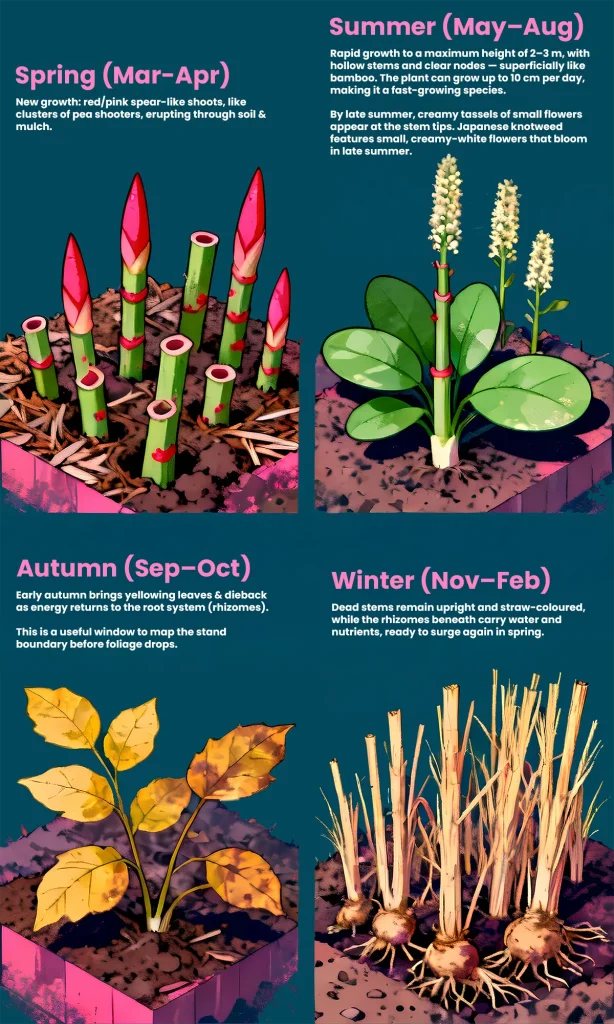TL;DR — Quick Facts at a Glance
- Key features: Hollow bamboo-like canes with purple speckles; heart/shield-shaped leaves with flat base; leaves alternate in a zig-zag; dense upright thickets; creamy-white flowers in late summer; dark brittle canes in winter.
- By season:
- Spring = red/purple “asparagus” shoots →
- Summer = 2–3 m canopy →
- Late summer–Autumn = white panicles, leaf yellowing →
- Winter = standing hollow canes/crowns.
- Look-alikes: Bamboo, lilac, bindweed, dock — confirm via zig-zag leaf pattern + hollow speckled stems.
- Risks: Invasive rhizomes can damage structures, reduce property value, and cause legal/mortgage issues.
- Do this: Don’t cut/dig. Request PCA-accredited survey & lender-friendly management plan (free ID available).
Japanese knotweed is an invasive plant that spreads fast and can damage structures and habitats. Because it’s often misidentified, the right checks matter before you act. It’s a big problem for homeowners, gardeners and land managers.
Early identification is pivotal – it prevents spread, limits damage, and makes treatment more effective.
This guide is for homeowners, landowners, and environmental professionals. This is a step-by-step visual guide to identify knotweed in any season.
Use our free Japanese knotweed identification service online where you can use knotweed identification tool or submit photos for expert review. Using our Japanese knotweed identification service, will get you a response within 24 hours.
Table of Contents
Identifying The Features of Japanese Knotweed
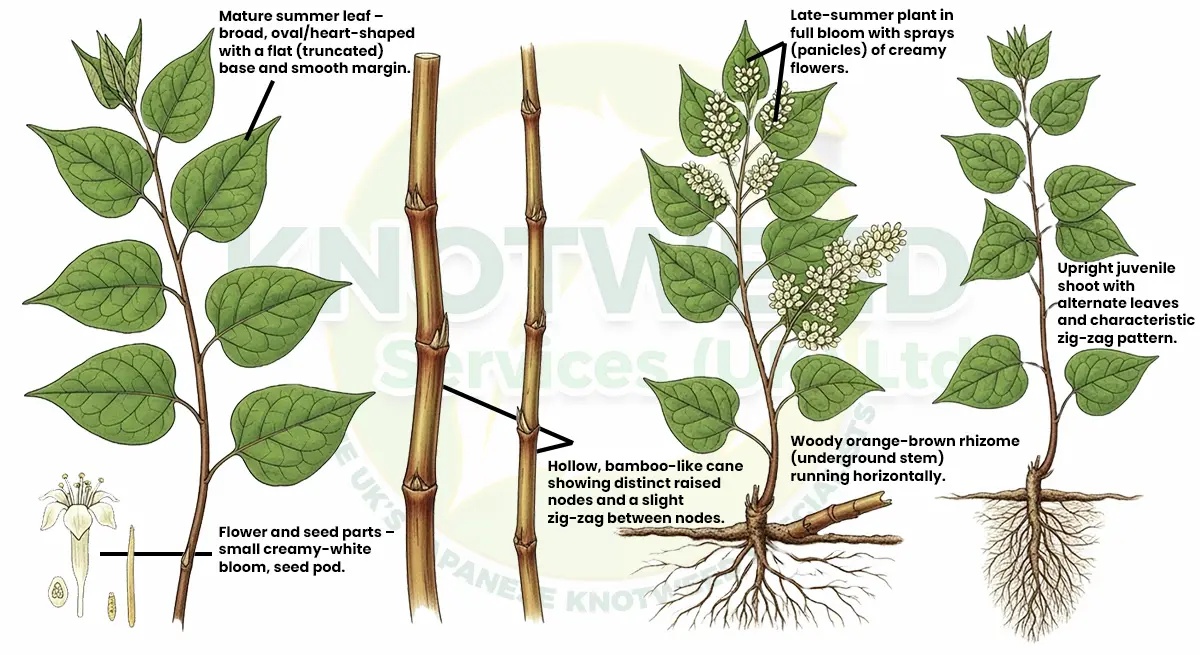
Japanese Knotweed (AKA Reynoutria japonica, Fallopia japonica, Polygonum cuspidatum) is a fast growing perennial from East Asia. Introduced to Europe and North America in the 19th century as an ornamental, its hardiness hid its invasive nature. It dies back in winter and regrows each spring from underground rhizomes.
The plant forms dense tall thickets that outcompete native plants and change ecosystems. Its highly invasive due to rapid growth, strong rhizomes and can thrive in many conditions especially disturbed soil. In summer it can grow up to 2-3 metres tall, forming dense thickets and lush green foliage, so it’s a dominant presence wherever it invades.

It harms ecosystems, can damage hard surfaces and drains, affects property values, and carries legal obligations.
Japanese knotweed is one of the most invasive plants in the UK. It grows in denschate groups blocking sunlight to native plants, reducing biodiversity and harming local wildlife. Its rhizomes can damage man made structures by growing through asphalt, blocking drains and weakening foundations, costing thousands to repair. It’s illegal to plant or allow knotweed to grow in the wild (Wildlife and Countryside Act 1981), and its waste is controlled under the Environmental Protection Act 1990.
Well known to cause problems when selling property, due to the TA6 form and mortgage lenders requiring a professional management plan. Japanese knotweed rhizomes are classed as controlled waste and can only be disposed of at a licensed landfill by professionals registered as licensed carriers. The UK economy loses about £41 million a year due to Knotweed, and there are also many legal issues to consider. The Environment Agency provides guidance on managing Japanese knotweed and other invasive non native plants.
How This Guide Will Help You: A Visual Guide to Identification
A season-by-season visual guide covering stems, leaves, flowers, and growth habit, with clear comparisons to look-alike species.
Japanese Knotweed Lifecycle: A Year-Round Visual Timeline
While numerous plants are typically only noticeable during their heightened growing periods, Japanese knotweed offers distinguishing features throughout every season. By understanding its characteristics and how it changes throughout the year you can take the first and most important step to control.
This timeline outlines its transformation from the vibrant growth of early spring to the dormant canes of winter, enabling you to recognize it at any time of the year.
Understanding the lifecycle makes it easier to spot Japanese knotweed, including its creamy white flowers in late summer, at any time of year.
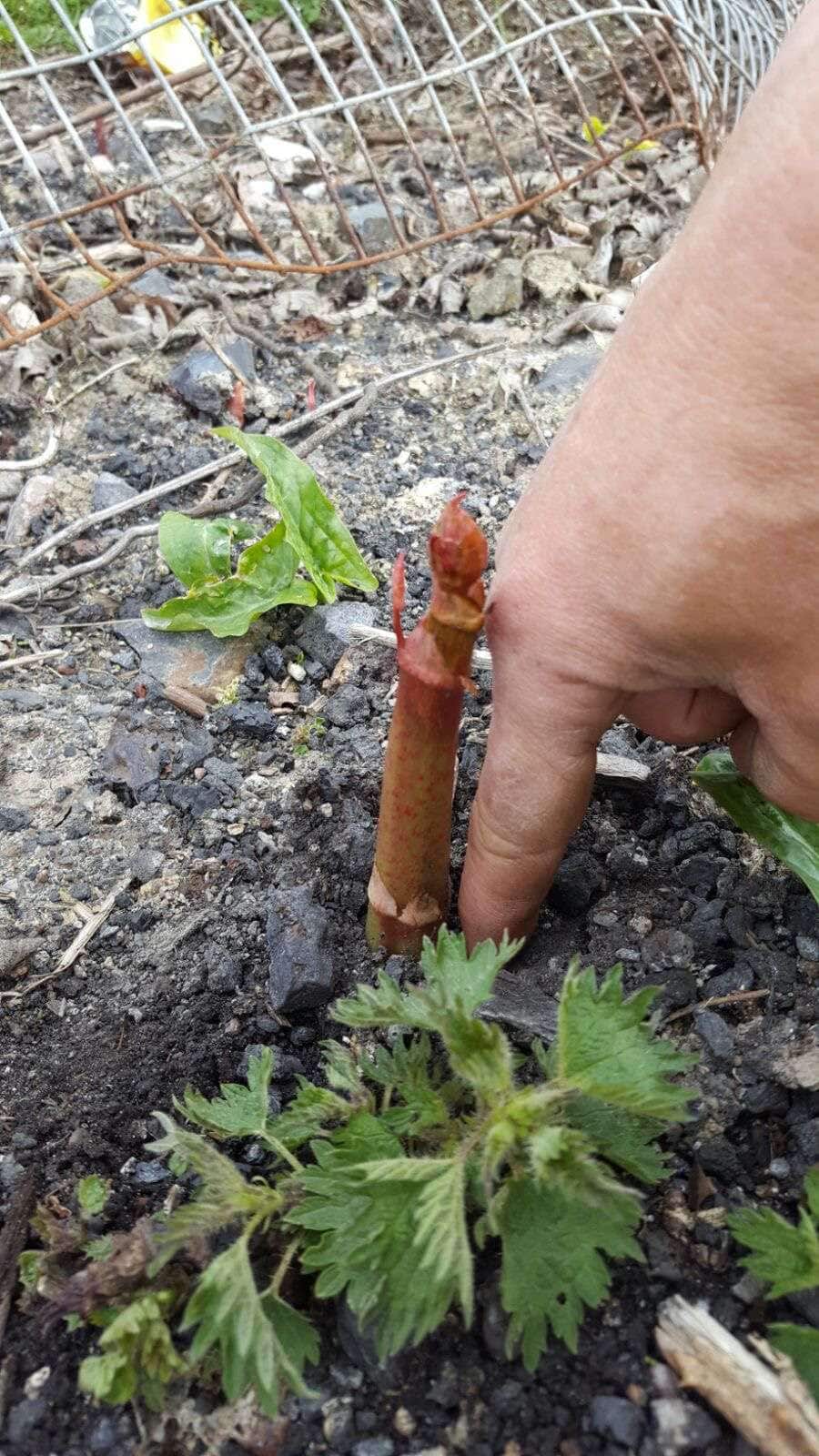
Spring: Emergence of Young Shoots (Shoots, Reddish-purple shoots, asparagus-like)
In early to mid spring the first signs of Japanese knotweed appear above ground as shoots. These shoots are the first indicators as they emerge from the crown and start the plant’s growth. The new shoots are obvious, often reddish-purple, with pointed growth pushing through the soil.
They look like asparagus spears because of their shape and speed of growth. These shoots can grow 10cm in a day so this is the critical stage for identification. They are fleshy and can be snapped easily.
As they grow they start to unfurl small, rolled up leaves. This is the critical stage for identification as the plant is smaller and more manageable than it will be later in the year. The bright colour and shape of these early shoots are the key identifiers that distinguish them from the new growth of most other garden plants.
Visit this page: Japanese Knotweed identification in spring for more detailed information.

Summer: Fast Growth and Maturation (Herbaceous shrub, mature stems, rapid spread)
Summer is when Japanese knotweed’s growth really gets going. The plant becomes a dense herbaceous shrub, often 2-3m (7-10ft) tall. The reddish-purple shoots from spring mature into hollow, bamboo-like japanese knotweed canes and japanese knotweed stems with green and purple speckles, which are especially prominent in mature plants.
The leaves fully open into their heart or shield shape and form a dense canopy that blocks out any light to plants below. This is the time of maximum spread, the rhizome system expands outwards to colonise new ground. The sheer density and height of a mature summer stand of knotweed is often the first thing that alerts you to an infestation.
Please read our: How To Identify Japanese Knotweed In The Summer guide for a more.

Late Summer/Autumn: Flowering and Seed Production (Flowers, creamy white flower clusters, panicles, achene)
August to October is the flowering period for mature Japanese knotweed plants and this is the time to identify. During this period the Japanese knotweed flowers appear as small creamy white clusters in long panicles.
These flowers are small but numerous and create a frothy or feathery effect that cascades from the leaf axils near the top of the stems. The presence of Japanese knotweed flowers means the plant is mature and healthy.
After pollination the plant can produce small triangular winged fruits called achenes that contain one seed. However in many areas like the UK most Japanese knotweed plants are female clones and seed production is rare. The plant relies on its rhizome network not seed dispersal for its spread.
Want to find out more click here: Recognising Knotweed in the Autumn.
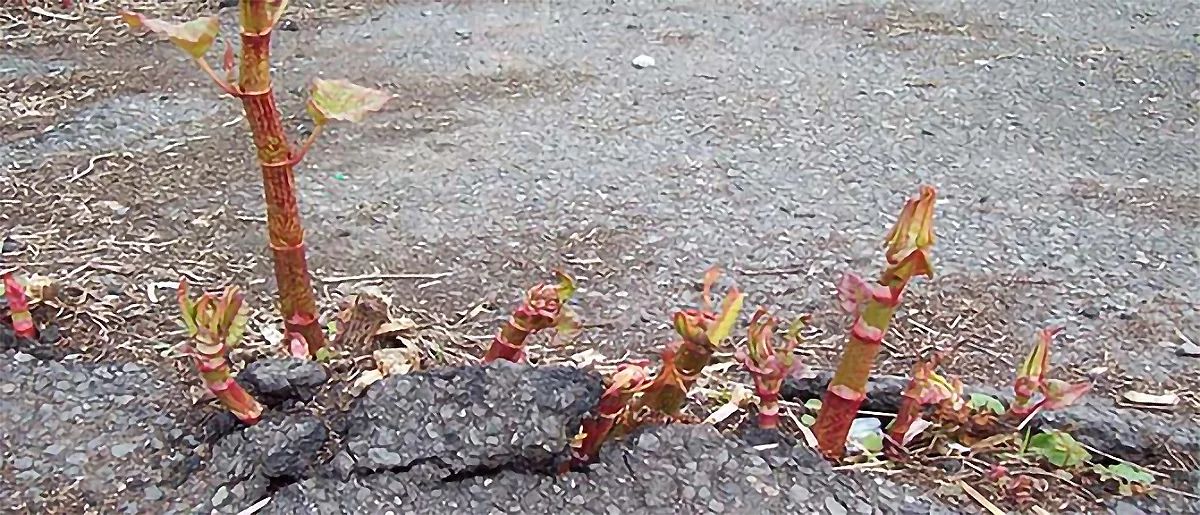
Winter: Dormancy and Persistent Canes (Dead canes, hollow stems, persistent structure)
After the first hard frosts of autumn the leaves of Japanese knotweed turn yellow and drop and the lush green stems die back and turn a dark brown. While the above ground growth is dead the plant is only dormant.
The extensive rhizome system is still alive and active beneath the soil storing up energy for the next spring’s growth. A key feature for winter identification is the persistent structure of these dead canes. Winter knotweed can also be identified by the presence of knotweed crowns, which are often visible above the soil surface alongside the standing canes.
The hollow bamboo like stems remain standing throughout the winter months often until they are broken by wind or snow. These dark brittle canes with their nodes are a clear sign of an infestation even when no living foliage is present. The canes also retain their zigzag pattern, which is another identifying characteristic.
For more information visit: Japanese Knotweed identification in winter.
Step-by-Step Visual Identification: Key Features
To accurately identify Japanese knotweed, you should closely examine the plant’s stems, leaves, flowers, and roots. Careful observation of these features is essential to confirm the presence of this invasive species.
It is especially important to watch for Japanese Knotweed growing in gardens, wild areas, or along property boundaries, as its spread can have significant environmental and legal implications. Follow these five detailed steps to thoroughly inspect any plant you suspect may be Japanese knotweed.
Step 1: Examine the Stems
The stems are often mistaken for bamboo and are one of the most distinctive features of the plant, making them key to identification.
Shape: The mature stem is hollow like a bamboo cane and has prominent raised rings or nodes at regular intervals where the leaves emerge. If you cut a stem you will find it’s empty inside.
Colour: In spring new shoots are reddish purple. As they mature through summer the stems turn a bright green, often with purple or reddish speckles. In late autumn and winter the dead canes are dark and brittle and can remain for a year or more.
Texture and Strength: The stems are smooth and segmented. While they are strong they are also quite brittle and can snap easily, especially when green.
Growth Habit: Stems grow upright and form dense clumps. This upright, cane-like growth is a characteristic of the species. The stems also grow in a distinctive zigzag pattern, which is a key feature for identification.
Step 2: Check the Leaves
The leaves of Japanese knotweed have a unique shape and arrangement that’s key to identification.
Shape: Japanese knotweed leaves are heart shaped or shield shaped with a pointed tip and flat base where the leaf stalk (petiole) attaches. They typically measure 10-15cm (4-6 inches) long, but some Japanese knotweed leaves can grow up to 200mm, giving them a distinctive shovel-like appearance.
Arrangement: One of the best identifiers is the leaf arrangement. They grow in an alternating, staggered pattern along the stem creating a zig-zag effect. Look at the main stem and see how the leaves emerge from one side, then the other, in an alternating sequence from each node.
Colour and Texture: Throughout the summer the leaves are bright green on top and lighter green underneath. Smooth to the touch with no hairs. In autumn they turn pale yellow before falling.
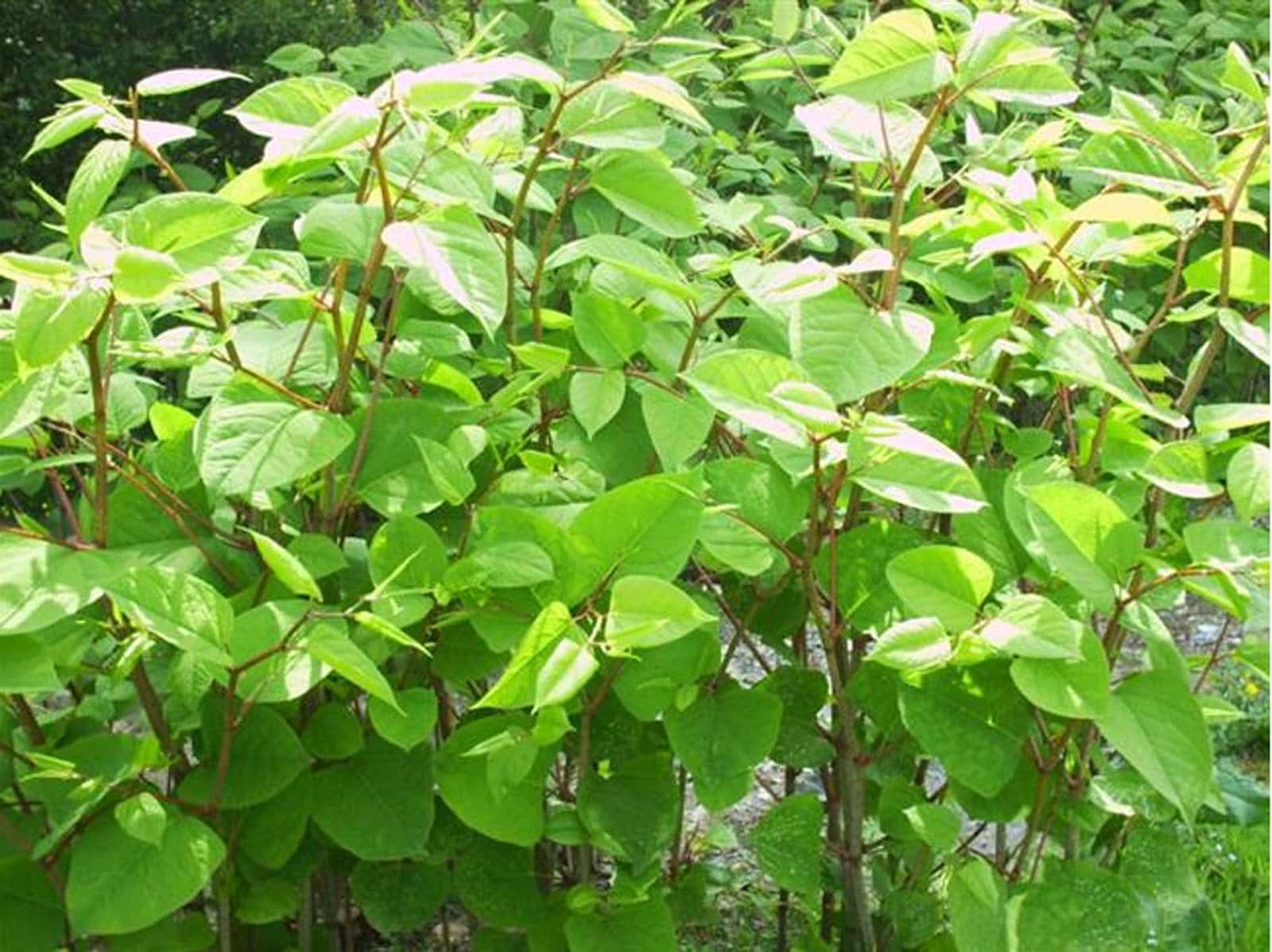
Step 3: Look at the Flowers
Flowers come late in the season and are a clear visual indicator.
Appearance: Masses of tiny creamy white or greenish white flowers. Individual flowers are clustered together in long branching spikes (panicles) up to 10cm (4 inches) long.
Location: Flower clusters emerge from the leaf axils (where the leaf meets the stem) mainly on the upper parts of the plant.
Timing: Flowers in late summer and early autumn, usually August to October. They give a delicate feathery look to an otherwise coarse and robust plant. Flowers confirm the plant is mature.
Step 4: Look at the Root System and Rhizomes (if visible)
Don’t dig unless you have to as it can spread the plant. Visible rhizomes in eroded soil or during excavation can confirm its identity and are key when identifying japanese knotweed roots.
Rhizome Appearance: The knotweed rhizome is a thick, woody underground stem. When broken or snapped, the inside is bright orange like a carrot, while the outside is dark and tough. This orange or yellow interior is a distinctive feature that helps with identifying Japanese Knotweed roots.
Growth: Knotweed roots, especially Japanese Knotweed roots, are the plant’s main survival and spreading mechanism. These roots and rhizomes can spread several meters from the parent plant and go deep into the soil. A tiny piece of knotweed root or rhizome as small as a fingernail can regenerate into a new plant, showing their resilience.
Visible Signs: In an established stand the ground may be bare due to the dense canopy. You may see the tough creeping knotweed roots and rhizomes just at the soil surface, especially on banks or disturbed ground.

Step 5: Overall Growth Habit and Height
Now step back and look at the plant as a whole.
Apperance: Japanese knotweed grows in dense, impenetrable clumps or stands. It creates a uniform canopy that chokes out all other vegetation.
Height: In one growing season it can grow up to 3m (10ft) tall, but 2m (7ft) is more common. This rapid growth and height is a key identifier. Even a small fragment of rhizome can produce an entirely new plant, allowing the species to regenerate and spread quickly.
Monoculture: A mature infestation will usually be a monoculture where Japanese knotweed is the only plant in a given area. This is because it outcompetes all other plants for light, water and nutrients.
Japanese Knotweed vs. The Imposters: Visual Comparisons with Look-Alikes
It’s often hard to identify Japanese knotweed because it can look like other plants with similar features. Many plants are often mistaken for Japanese knotweed due to their similar appearance. Misidentifying other plants as Japanese knotweed can be alarming.
Missing a real knotweed infestation can give you a false sense of security and let it spread and get worse. In this section we’ll show you clear visual comparisons to help you tell Japanese knotweed apart from lookalikes.
By understanding these differences you’ll be better equipped to identify real knotweed infestations and take action.
Why Misidentification is Common (Similarities, other invasive plant species)
Misidentification is common because several plants have one or two features in common with Japanese knotweed. For example another plant may have similar shaped leaves, a bamboo like stem or a tall dense growth habit. Gardeners and landowners often mistake common plants like bindweed, lilac or dock for knotweed especially in the early growth stages in spring.
Other invasive plants, including invasive weeds such as other types of knotweed, can make identification harder. A correct ID requires looking at the combination of features – leaf shape, stem structure, flower type and growth habit – rather than just one.
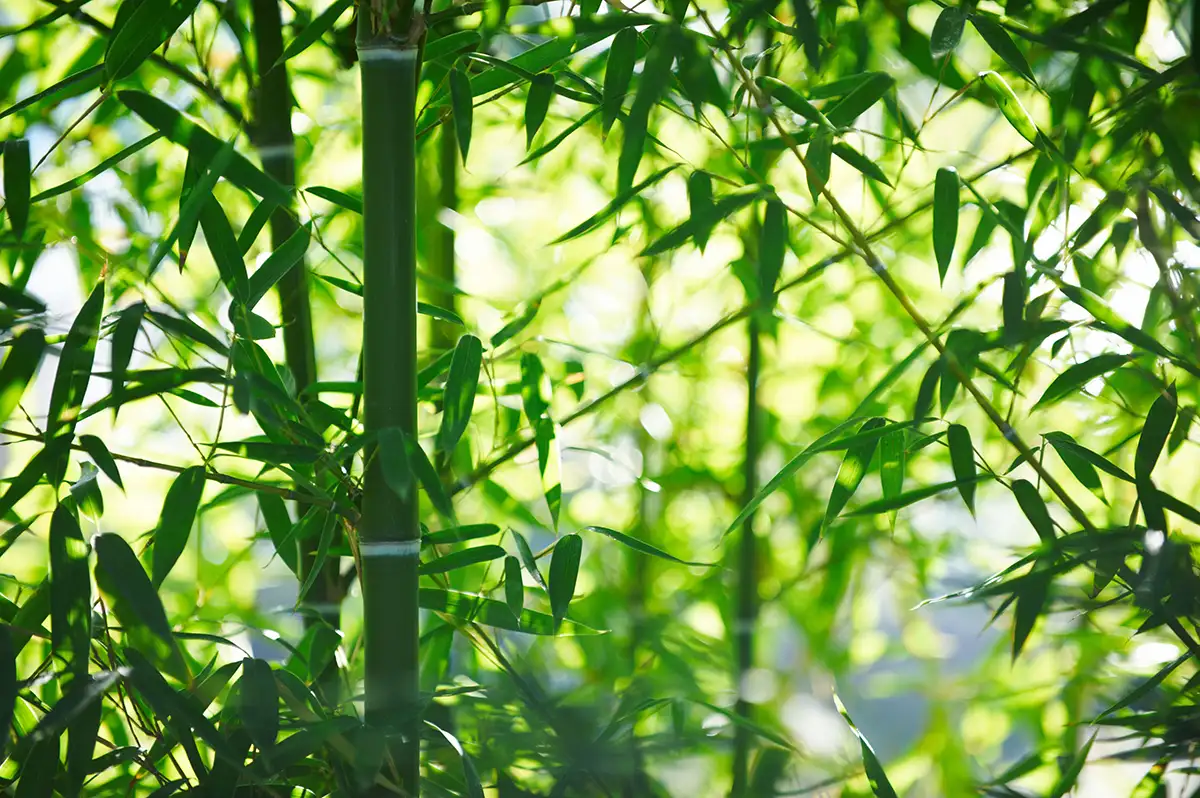
Bamboo (Bambuseae): Stems and Leaves (Bamboo stems, hollow stems, nodal structure, leaf shape comparison)
Bamboo is the most confusing due to its similar segmented, hollow stems.
Stems: Both have hollow, segmented stems with a nodal structure, but bamboo stems are harder, woodier and more fibrous. They are tan, yellow or dark green and don’t have the purple speckles of a Japanese knotweed stem. Bamboo canes last for many years, knotweed canes die back every year.
Leaves: Bamboo leaves are very different. Long, slender and lance shaped, like large blades of grass. Totally different from the broad, heart shaped leaves of Japanese knotweed.
Sheath: Bamboo stems have a papery sheath at each node, knotweed doesn’t.

Lilac (Syringa vulgaris): Identifying Young Shoots and Leaf Structure (Early shoots, leaf arrangement, bud structure)
In spring, the early shoots of lilac can be confusing.
Stems: Lilac is a woody shrub with solid stems, not hollow canes. Even the young shoots are woody, not fleshy like knotweed.
Leaf Arrangement: Lilac leaves are opposite, two leaves from the same node on opposite sides. Knotweed leaves are alternate, zig-zag.
Leaf Shape: Both have heart shaped leaves, but lilac leaves are smaller, duller green and more rounded with no flat base like knotweed leaves.
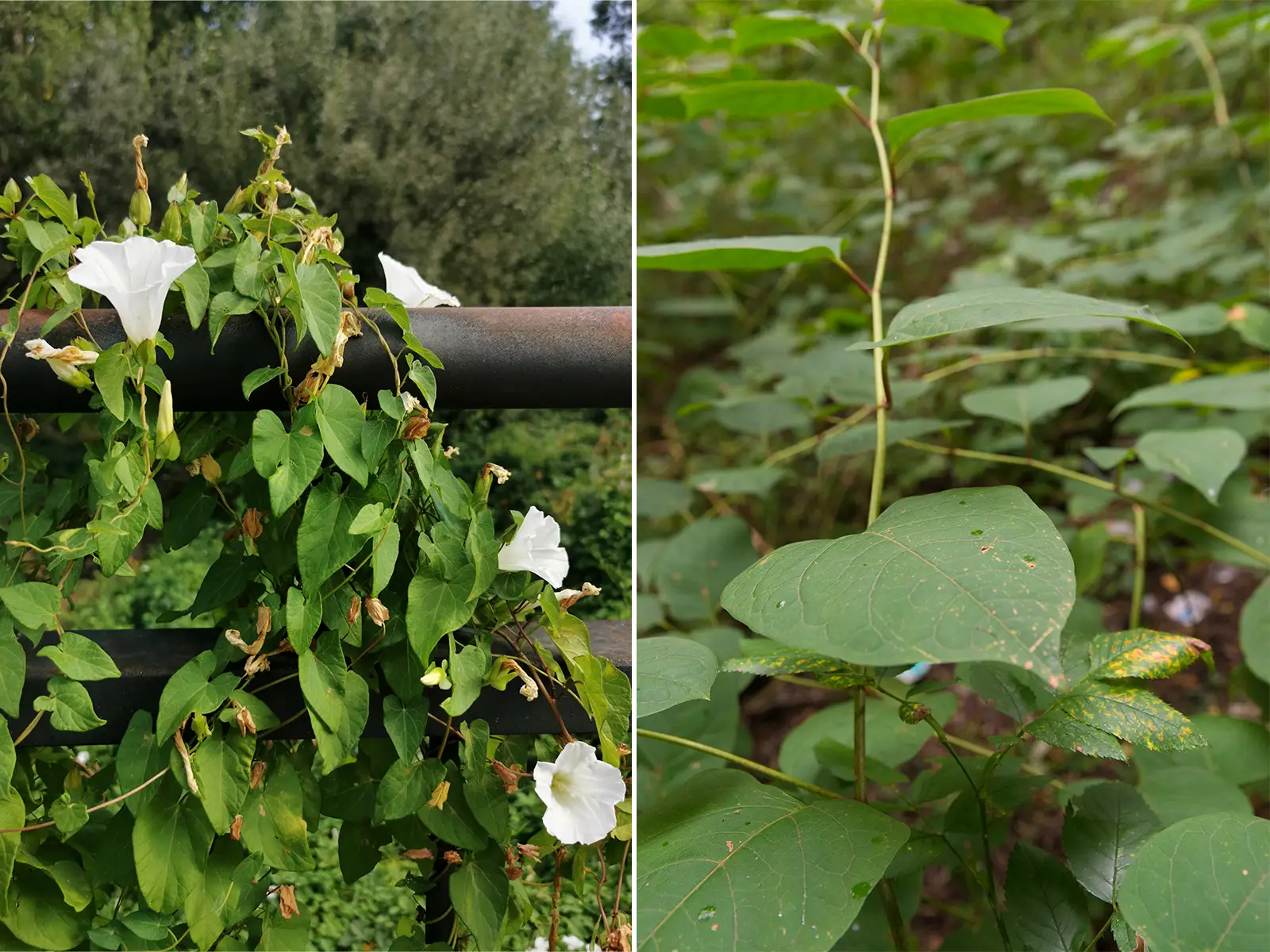
Bindweed (Convolvulus arvensis): Growth Habit and Leaf Differences (Vining vs. erect growth, leaf shape comparison, tendrils)
Bindweed is another one that can be confusing because of the similar leaves.
Growth Habit: This is the key. Bindweed is a climber or trailer, it doesn’t have self-supporting, upright stems. It twines around other plants, fences and structures with its flexible, tendril-like stems. Japanese knotweed grows in strong, erect canes.
Leaf Shape: Bindweed leaves are arrowhead shaped with pointed lobes at the base pointing backwards. Similar to knotweed’s heart shape but arrowhead is distinct.
Flowers: Hedge bindweed produces small creamy white flowers, which are trumpet shaped and help distinguish it from Japanese knotweed’s tiny, creamy white flower clusters.

Broad-Leafed Dock (Rumex obtusifolius): Leaf Shape and Flower Differences (Leaf base, flower structure, stem characteristics)
Dock is a common “weed” whose big leaves can be mistaken for young knotweed.
Leaves: Dock leaves are big and can be heart shaped but they are much longer and more oval or oblong than knotweed leaves. They have wavy or crinkled edges and a rounded not flat base. Young dock leaves grow in a rosette formation close to the ground.
Stems: Dock stems are grooved or ridged and not hollow. They don’t have the zig-zag pattern of knotweed.
Flowers: Dock produces tall spikes of small greenish flowers that turn rusty brown as they mature into seed heads which persist through winter. This is very different from knotweed’s delicate white flowers.
Other Knotweed Species and Hybrids: A Quick Guide
And to make things even more complicated there are several varieties including Reynoutria japonica var. and other related knotweed species and hybrids.
Giant knotweed (Reynoutria sachalinensis): Very similar to Japanese knotweed but much bigger, up to 4-5 metres (12-16 feet) tall. Leaves are much bigger (up to 40 cm long) and have a more rounded heart shape with a deeply indented base, rather than flat.
Bohemian knotweed (Reynoutria x bohemica): This is a hybrid of Japanese and Giant knotweed. It’s a mix of both. Leaves are bigger than Japanese knotweed but smaller than Giant knotweed and can vary in shape. It’s as invasive and often more vigorous than either parent species.
Himalayan knotweed (Persicaria wallichii): Himalayan knotweed is a tall, slender plant with long, narrow leaves and white to pale pink flowers. It differs from Japanese knotweed by its elongated leaves and less robust stems. It’s native to the Himalayas and has spread in the UK, but is less common than Japanese knotweed.
Dwarf Japanese knotweed / Dwarf knotweed (Reynoutria japonica var. compacta): This compact variety grows up to 1 metre tall, much shorter than typical Japanese knotweed. It has smaller, more rounded leaves with a bluish-green tint and a less aggressive growth habit, making it easier to distinguish from the standard species.
Lesser knotweed (Persicaria campanulata): Lesser knotweed is a smaller species with narrower, more lance-shaped leaves and a hairy underside. It’s native to the Himalayas and can be differentiated from Japanese knotweed by its leaf shape, size and the presence of fine hairs on the leaves.
For a more in-depth guide to similar plants – click -> Mistaken Plants That Look Like Japanese Knotweed.
“Spot the Difference” Checklist: Key Features to Confirm Knotweed
When in doubt, run through this quick checklist:
Knotweed Hotspots: Where You're Most Likely to Find It
Japanese knotweed is a resilient plant that can grow in a variety of environments, but it has a clear preference for certain habitats. Understanding where it is most likely to thrive can help you be more vigilant in your monitoring efforts. Its prevalence is staggering; a 2021 study revealed that of 3,893 equally divided areas across Britain, knotweed had affected 3,134 of them.
The plant is commonly found along roadsides, riverbanks, waste ground, and in other neglected areas, where its invasive nature allows it to dominate and spread rapidly. New plants can arise from even small fragments of rhizome or stem, making early identification and control essential to prevent further spread. Check out our Japanese Knotweed Map for more info.
Disturbed Land and Construction Sites (Soil, plant spread)
Japanese knotweed loves disturbed land. Construction sites, brownfield sites and areas with recently moved soil are perfect for new infestations. The rhizomes are easily broken and spread through the movement of contaminated soil during excavation and landscaping.
A small piece of rhizome in a truckload of topsoil is all it takes to start a new colony. The loose, uncompacted soil of these sites gives little resistance to the rapidly growing rhizome system.

Riverbanks and Riparian Zones (Riparian areas, streambanks, erosion control)
Riparian zones – the land alongside rivers and streams—are Japanese knotweed’s favourite habitat. It likes moist fertile soil. Water is a major vector for its spread. Pieces of rhizome can break off from an upstream infestation, get washed downstream and deposit on a new bank where they can establish a new plant.
Both Japanese knotweed and Himalayan balsam are invasive species commonly found along riverbanks and riparian zones, where they outcompete native vegetation and spread rapidly. Its dense root system can stabilise a bank initially but in winter the canes die back and the bare soil is left exposed and highly erodible.

Gardens, Allotments and Unmanaged Areas (Habitat, gardeners)
Many current infestations come from historical plantings in gardens when it was sold as an ornamental. Gardeners didn’t know it was invasive and may have unknowingly spread it by sharing cuttings or not disposing of garden waste properly. It escapes from cultivation into adjacent unmanaged areas such as woodland edges, parks and vacant lots. Allotments are another common habitat where it can spread from one plot to another through soil cultivation and shared tools.
Roadsides and Railway Embankments (Infrastructure damage)
Roadsides and railway embankments are hotspots for Japanese knotweed. The verges are often made of disturbed, imported soil and are managed regularly which can spread the plant. Mowing or strimming can shatter the canes into pieces and while stem cuttings are less likely to root than rhizome fragments, it’s still a means of spread.
The presence of knotweed along these corridors is a direct threat to the infrastructure itself, it can damage asphalt, signals and retaining walls.
How to Identify Japanese Knotweed Year-Round
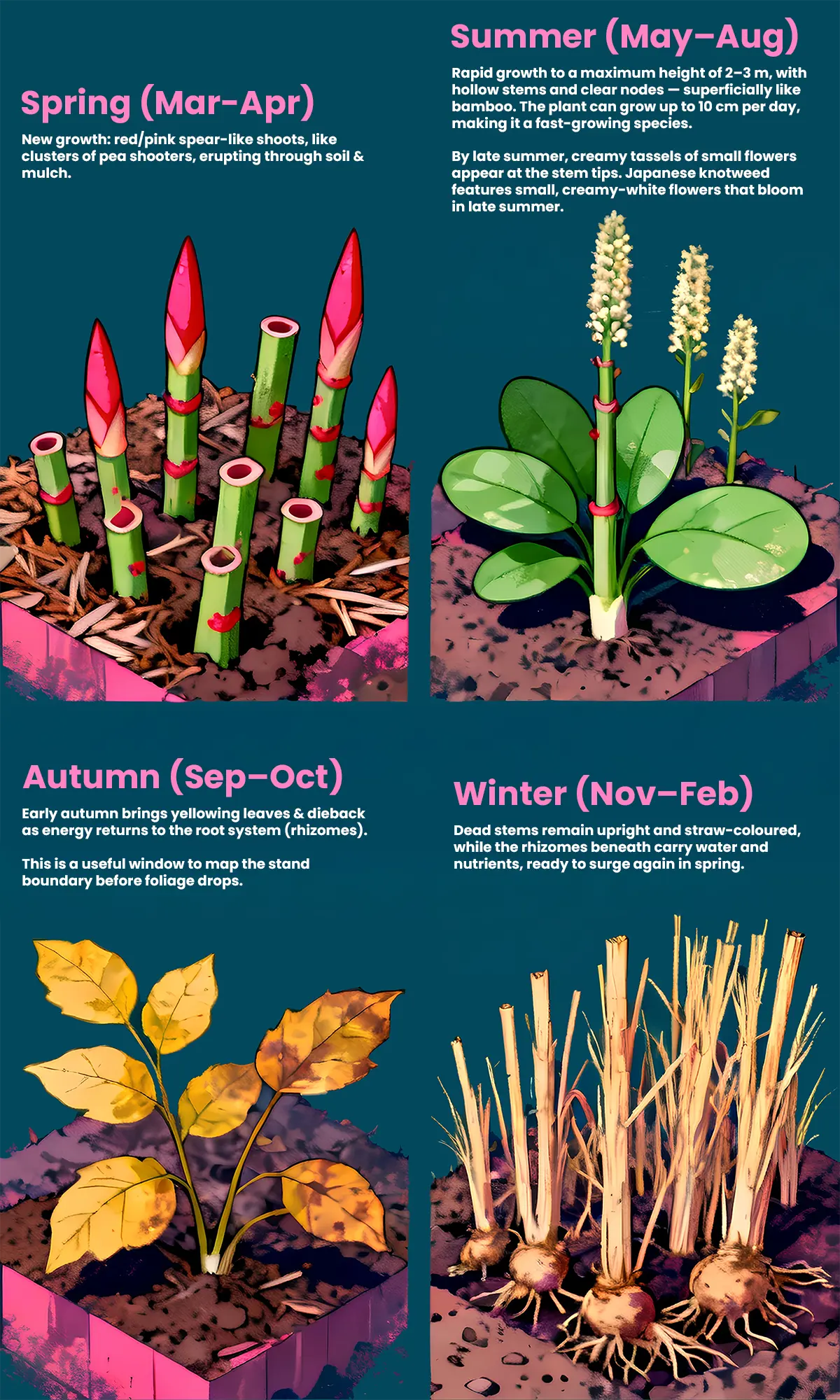
The plant is well known for having stems that look like bamboo which can be deceiving to the untrained eye. And its leaves are heart shaped and in an alternating, zig-zag pattern along the stems, this is a key feature to look for. Japanese knotweed looks different in each season. This makes it hard to identify. It is important to correctly identify Japanese knotweed. It helps to manage and control this invasive species. To do so, observe its features carefully.
The reddish, asparagus-like shoots appear in spring.
The dense green canopy grows in summer.
Delicate white flowers bloom in autumn.
The dead canes stay through winter.
These help to identify the plant all year round.
Knowing how to tell Japanese knotweed from other plants is key. It saves you from false alarms and costly mistakes. Use the visual guides and checklists to build your confidence in spotting this unwanted guest. It affects many UK properties. 4-5% of homes. A total of a £20 billion loss in total property value!
If you think you have Japanese knotweed on your property after using this guide, seek professional confirmation and advice. Our Japanese knotweed experts can identify it for you and create a plan for your situation.This plant is resilient, and there are legal guidelines for managing and disposing of it.
DIY removal often fails and can make the problem worse. Chemical control, such as using herbicides, is a common method for Japanese knotweed control but often requires professional application to be effective and legal. The easiest and best way to remove Japanese knotweed is to hire a professional company (that speicalises in a Japanese Knotweed Surveys and removal) that specialises in invasive weed removal.


